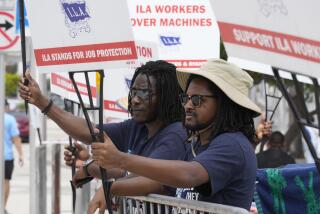Labor Unions, Nassco Reach Tentative Pact
- Share via
SAN DIEGO — Ending a three-week strike, six labor unions and the National Steel & Shipbuilding Co. reached agreement Tuesday on a tentative contract, and both sides said workers may be back on the job as early as Friday.
The agreement was reached late Tuesday afternoon after a daylong negotiating session, but union negotiators said the “principal problems” were actually ironed out during an informal meeting over the weekend.
Wages and job security had emerged as the main stumbling blocks in the dispute. Union officials declared victory Tuesday, even though they were unable to obtain the wage concessions they had held out for. Under the proposed contract, workers will still earn less than they did 12 months ago.
Vote Scheduled Thursday
The union membership, which worked without a contract for almost 11 months before it walked out Aug. 10, will vote on the tentative pact Thursday. Union leaders said they will recommend ratification to their approximately 1,000 members. The old contract expired Sept. 30, and the unions had rejected three contract proposals made by the company over the past year.
“We won because we achieved the goal that was most important to our members: the protection of their jobs. Job security was more important than wages,” said Robert Godinez, president of Local 627 of the Ironworkers Union. The unions received assurances from the company that lower-paid trainees would not be used to displace journeymen.
But, on the wage issue, the six unions, negotiating as a team against Nassco, failed to obtain the minimum $12 an hour they were demanding for journeymen. The proposed 49-month contract calls for journeymen to receive $11.40 an hour upon ratification, followed by two hourly pay increases of 25 cents each in the final two years of the agreement. Unskilled workers would be paid $7 an hour upon ratification.
In addition to the pay increases, the proposal calls for cost-of-living increases that could reach $1.20 an hour. Union negotiators also accepted a company offer to institute profit sharing beginning next year.
Nassco spokesman Fred Hallett said that, with the wage increases and possible profit-sharing disbursements, journeymen could be earning up to $15.72 an hour when the agreement expires in 1992.
Nassco, the only privately owned shipyard on the West Coast that is not in bankruptcy, reported $20 million in losses for the second quarter of 1988. In June, officials from Morrison-Knudsen, the shipyard’s parent company, said there were no new shipbuilding contracts in sight for Nassco and predicted continuing financial problems.
‘Month-to-Month Thing’
“Nassco’s survival is now a month-to-month thing,” said Peter Zschiesche, business agent for Lodge 389 of the International Assn. of Machinists and spokesman for the six unions. “We hope that the company survives. We want the work.”
Considering the shipyard’s financial status and dwindling Navy contracts, Zschiesche said he was satisfied that the unions got as much as they could from the company. Nassco now has only a $290-million contract for construction of the AOE, a speedy Navy combat support ship, and a $60-million repair contract that is scheduled to end in November.
“I’m satisfied that we got all that we were going to get. I can honestly say that I don’t think there’s any more there,” Zschiesche said.
Nassco officials unilaterally cut workers’ wages, ranging from 17% to more than 50%, a few days after the old contract expired. Journeymen’s wages were reduced to $10.80 an hour, from $12.80. Unskilled workers suffered a bigger cut, going from $12.05 an hour to $5.55 an hour.
Company officials said the cuts and lower wages were necessary to keep the shipyard competitive with yards on the Gulf and East coasts. On Tuesday, union negotiators said they were not convinced of that, but acknowledged that a change in the Navy’s shipbuilding plans has contributed to the company’s decline.
“We’ve had higher wages than the South for 50 years and more. . . .” Zschiesche said. “We’ve had our share of work before, but politics is now playing a role in the way shipbuilding contracts are parceled out. Obviously, things have changed upstairs (in Washington).”
Union Problem Remains
Hallett said Nassco is pleased with the agreement.
“Nobody’s pleased with the (shipbuilding) environment that we’re in . . . but the package is acceptable and we believe that with it we can remain competitive in the industry,” he said.
The unions still have a sticky problem to work out among themselves. A seventh union, the International Brotherhood of Electrical Workers, Local 569, reached an agreement with Nassco the day before the strike. Until that time, the seven unions had been negotiating as a team. More than half the electricians did not honor the other unions’ picket lines, and some striking workers have vowed retribution.
“There is going to be a lot of hard feelings directed toward the electricians. . . . We didn’t want that to happen. They were good participants in our struggle up until a month ago,” Zschiesche said.
Striking workers walking picket lines took photographs of the electricians who crossed the lines, and posted them on a board called the “Scab Report.”
The other six unions represent ironworkers, machinists, carpenters, Teamsters, crane operators and painters.
More to Read
Inside the business of entertainment
The Wide Shot brings you news, analysis and insights on everything from streaming wars to production — and what it all means for the future.
You may occasionally receive promotional content from the Los Angeles Times.









